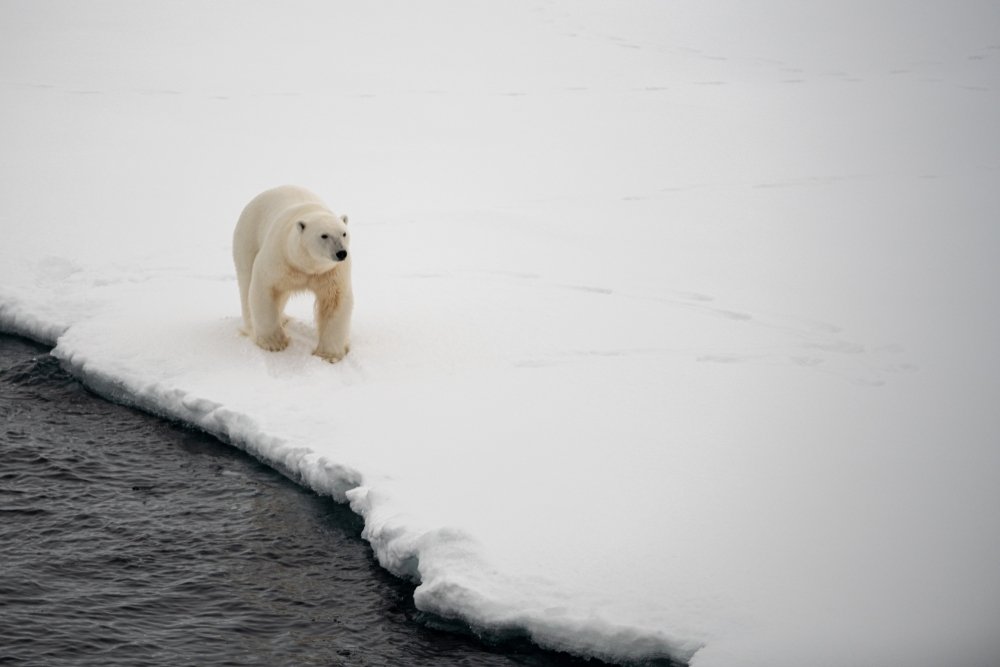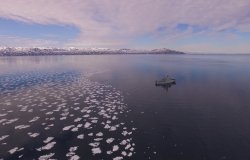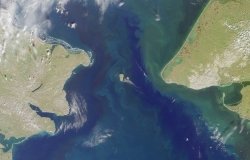
A blog of the Polar Institute
No. 19 | Seeking Deterrence in the High North
An analysis of the strategic and operational considerations of maritime deterrence in the High North, based on the Polar Institute's February 9, 2023 event.

Shutterstock/USCGC HEALY (WAGB 20) on Sep. 22, 2023
While the United States and its NATO allies are carefully navigating their support of Ukraine in its conflict with Russia, the alliance has otherwise asserted itself in an ongoing campaign of deterrence aimed at Moscow. The 2022 U.S. National Defense Strategy (NDS) notes that the Department of Defense “will support robust deterrence of Russian aggression against vital U.S. national interests, including our treaty Allies.” The NDS uses a broad-brush concept of deterrence: “deterrence is strengthened by actions that reduce a competitor’s perception of the benefits of aggression…” including both conventional and nuclear deterrence.
But a broad definition can create its own challenges: as Michael Kofman has noted about “this ethereal substance known as conventional deterrence,” it can be hard to measure: “How do you know when you have it? Lost it?” And when it comes to the Arctic region, where a complex set of conventional and strategic deterrence considerations play out across multiple domains, questions about how successfully the U.S. and its allies are pursuing deterrence are especially acute.
How are we reducing Russia’s perception of the benefits of aggression in the Arctic, specifically, in the maritime domain? In order to explore this question, the Wilson Center’s Polar Institute partnered with the Center for Maritime Strategy to host an event with experts and naval leaders on February 9, 2023. This discussion occurred against the backdrop of the U.S. Navy’s return to the Arctic, in the form of regular operations and exercises in Barents Sea—including the October 2022 deployment of the new USS Gerald R. Ford aircraft carrier to the North Atlantic. We offer key takeaways from the discussion here.
High North Deterrence
Deterrence does not occur in a vacuum. Perhaps the single most decisive factor in deterrence is the motivation of the potential adversary. In this region, Russia is a highly motivated actor. As the largest Arctic nation, and one that has an extraction-based economy, Russia has several key strategic interests in the region. The Arctic serves as Russia’s economic linchpin and is integral to their military efforts in the High North and western Europe. As polar sea ice melts and exposes Russia—which has the longest Arctic coastline—to new risks, defense of this region is now at the forefront of Russian maritime doctrine, contingency planning, and lawmaking. In contrast to the U.S. perception of the High North as simply the northern flank, the Arctic is seen by Russia as its “front door.”
Another important element in deterrence is clearly communicating what a defending nation wishes to deter. NATO must determine what it specifically wishes to deter Russia from doing. Are the U.S. and its allies clear on their specific deterrence objectives? What Russian actions are targets of deterrence? Mathieu Boulegue points out that U.S. and its allies face the challenge of a Russia that has experienced 30 years of self-mythologizing as an Arctic civilization, 30 years of Kremlin propaganda about the threat from NATO, 20 years of Putinism, and 10 years of information warfare and social engineering. The cumulative effect of these decades of propaganda cannot be discounted as the U.S. seeks to shape Russia’s behavior in the High North. Boulegue also notes Russia’s Arctic-specific “double dual” approach, which has guided the extensive maintenance and recapitalization of infrastructure in the High North: “Arctic infrastructure is being used for civilian and military purposes (dual-use), while Russia is also blurring the lines between offensive and defensive intent (dual-purpose).” Thus, the challenge for NATO is to determine what Russian behavior it is willing to accept, and which behavior it wishes to prevent.
What is the right balance to deter without escalating?
Rather than thinking in terms of a compete-or-cooperate binary, speakers at the February 9 event agreed that the U.S. and its allies should adopt a managerial approach to the relationship with Russia in the Arctic: management based on a set of strategic principles will allow adaptive approaches and flexibility, and engender a long-term mindset. A management approach also requires the U.S. and allied militaries to posture against Russian strengths, preferred means, and known strategic and operational concepts. For example, knowing that Russian doctrine relies on conventional strikes against strategically important targets, the U.S. and its allies can contribute to deterrence through hardening such targets through investing in integrated air and missile defense.
Another area that deserves greater focus is the undersea domain: Russia retains formidable undersea capabilities in strategic, conventional, and hybrid warfare. Undersea warfare capabilities are critically important to prevent Russian platforms from operating unopposed in the North Atlantic and off the eastern United States. The attack on the Nord Stream 2 pipeline in 2022 served as a stark reminder of the vulnerability of undersea critical infrastructure; as did the 2021 attack on fiber optic cables connecting Svalbard to mainland Norway. Russia can hold transatlantic sea lines of communication at risk and challenge U.S. strategic interests below the level of armed conflict. In response, Admiral James G. Foggo called for an increased focus on infrastructure resilience and emphasis on seabed cables. The private sector clearly has an important role to play in this space. Governments and the private sector should cooperate to ensure that key systems are resilient, able to survive attack and recover quickly.
A management approach, coupled with the likelihood of hybrid maritime threats, should add urgency and focus to the U.S. Coast Guard’s recapitalization of its icebreaking capability. The new polar security cutters, along with existing Coast Guard capabilities, have an important role to play in maritime governance and stabilization in the High North. Coast Guard ships are less escalatory than naval vessels, and the Coast Guard upholds the rule-based international order in the Arctic by working through allies and international organizations like the International Maritime Organization, Arctic Council, and Arctic Coast Guard Forum.
What lessons can be learned from recent exercises and operations?
Admiral Daryl Caudle, Commander of U.S. Fleet Forces, argued that fielding additional capabilities related to command, control, communications, intelligence, surveillance and reconnaissance (C4ISR) will be key to ensuring domain awareness in the High North. While the Navy’s Task Force 59 has its critics, it may enable the Navy to field its first-ever unmanned surface fleet. Task Force 59 is supporting the development of a network of sensors, radars, and cameras that can provide persistent maritime domain awareness, analyzed via artificial intelligence. The concepts developed by Task Force 59 will feed into the DoD’s Joint All-Domain Command and Control (JADC2) concept to support universal domain awareness.
However, as Admiral Foggo reminded, “virtual presence is actual absence.” Maritime operations and exercises are vital to demonstrate U.S. and allied interest and resolve in the High North region.
The U.S. has a distinct advantage in the High North due to its robust network of friends and allies in and around the region. The region remains a top priority for Norway, and with Russia’s increasingly provocative behavior—including GPS interference endangering civilian air traffic—the Norwegian government is eager to more closely integrate with the U.S. and other regional partners. These close ties cut both ways: while 85% of regional exercises and operations are nationally-led, Russia views all this activity as occurring under the NATO banner. As a result, it is crucial for the U.S. and its allies to assess the net deterrence effects of their activities.
Deterrence, in the NDS vision, is a whole-of-government effort: coordinated across military, economic, diplomatic, and legal tools. Commercial, civilian, and military elements can be deployed against Russian strengths and preferred means to signal resolve and uphold the rules-based order. Comprehensive approach to security must include both deterrent measures and contingency plans for when deterrence fails.
About the Authors

Polar Institute
Since its inception in 2017, the Polar Institute has become a premier forum for discussion and policy analysis of Arctic and Antarctic issues, and is known in Washington, DC and elsewhere as the Arctic Public Square. The Institute holistically studies the central policy issues facing these regions—with an emphasis on Arctic governance, climate change, economic development, scientific research, security, and Indigenous communities—and communicates trusted analysis to policymakers and other stakeholders. Read more













